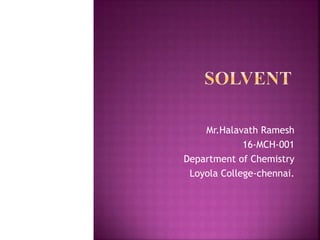
Solvent
- 1. Mr.Halavath Ramesh 16-MCH-001 Department of Chemistry Loyola College-chennai.
- 2. Solvent : A solvent is a substance that dissolves a solute resulting in a solution. A solvent is usually a liquid but can also be a solid, a gas or a super critical fluid. When one substances is dissolved into another a solution is formed. Generally the dielectric constant of the solvent provides a rough measure of a solvents polarity. The strong polarity of water is indicated its high dielectric constant of 88(at 0oc) Solvents with a dielectric constant of less than 15 are generally considered to be non-polar. Solvents with dielectric constant of greater than 15 are called polar solvents. Polar solvents can be divided into two types 1. Protic solvent 2. Aprotic solvent
- 4. Polar Solvent: Polar solvents contain bonds between atoms with very different electro negativities , such as oxygen and hydrogen and have large dipole moment. Non-Polar Solvent: Non- polar solvents contain bonds between atoms with similar electro negativities such as carbon and hydrogen. These polar solvents are capable of forming hydrogen bonds with water to dissolve in water whereas non- polar solvents are not capable of strong hydrogen bonds. Polar Protic solvent: Polar Protic solvents are capable of forming hydrogen bonding because they Contain at least one hydrogen atom connected directly to an electronegative atom( such as O-H or N-H bonds).They solvate Cation and anions effectively. Polar Protic solvents are water, ethanol, methanol,ammonia,acetic acid and other.
- 5. Polar Aprotic solvent: Polar Aprotic solvents are contain no hydrogen atoms connected directly to an electronegative atom and they are not capable of hydrogen bonding .These are acetone, dimethyl sulfoxide(DMSO),DMF(N,N-Dimethyl formide ,Acetonitrile,HMF(Hydroxy methyl furfural ,crown ether and other)
- 8. In fact semi polar compounds can act as intermediate solvents to bring about miscibility of polar and non polar solvent. partly polar —used especially of chemical bonds and structures regarded as possessing polarity associated with nonpolar covalence (as in an amine oxide R3N+−O−)
- 9. The term miscibility refers to the mutual solubility of the components in liquid –liquid systems. Polar and semi polar solvents, such as water and alcohol, Glycerin and alcohol, alcohol and acetone are said tobe completely miscible because they mix in all proportions. Non-polar solvents such as benzene and carbon tetra chloride are also completely miscible.